Affiliate disclosure: This post may contain affiliate links. Please see our Privacy Policy.
Jewelweed (Impatiens capensis) is a common edible and medicinal wildflower that’s easy to find and identify. It’s most commonly used to treat bug bites and poison ivy, but that’s just the beginning.
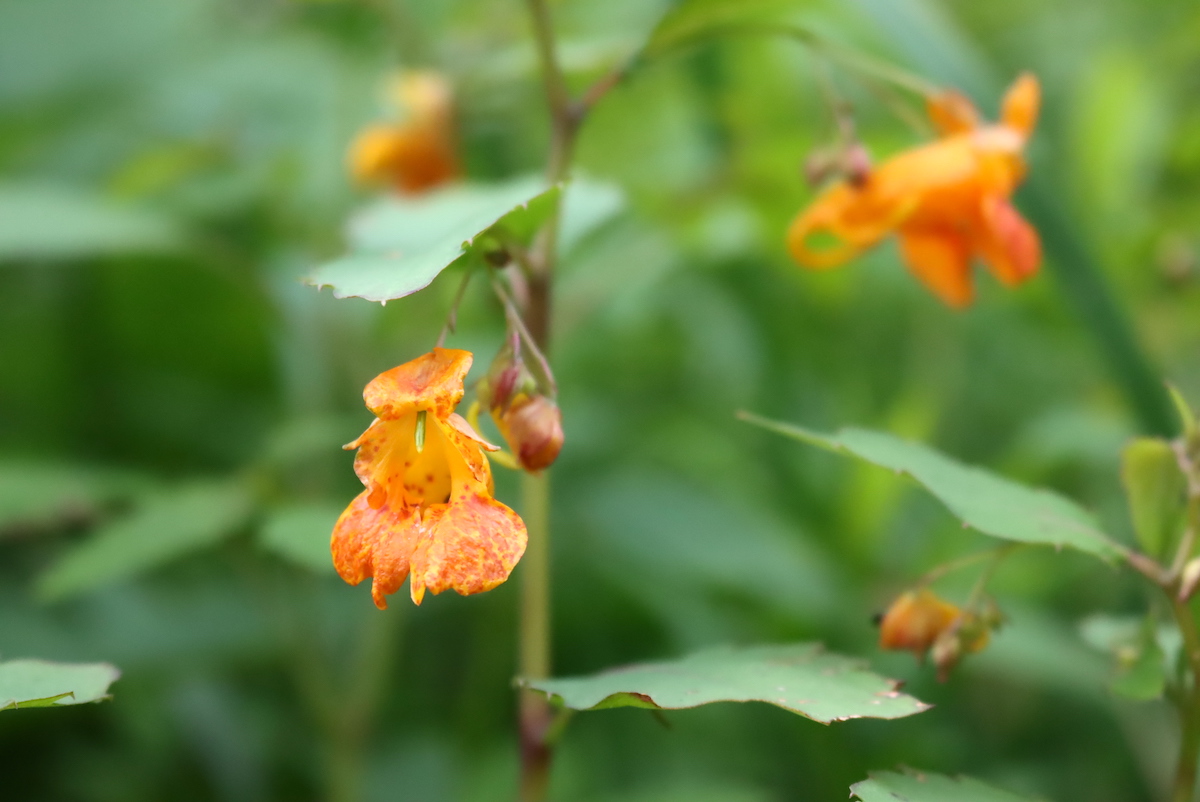
A few years back, my friend Colleen from Grow Forage Cook Ferment visited our Vermont Homestead. I was walking her through our garden, and she spotted a big patch of jewelweed growing under an apple tree at the edge.
It was the first time she’d see the plant, and she got all excited. “Is that Jewelweed!?!?! Did you plant it?” she asked.
I laughed. Nope, it’s a weed, and it grows everywhere here in Vermont.
In fact, it loves land with cool, wet soil, which is exactly the opposite of what you should have under an apple tree. As the saying goes, apple trees hate wet feet.
I didn’t plant the jewelweed, but I did plant that apple tree. The fact that a lush patch of jewelweed is thriving beneath shows that the apple tree is not long for this world, and I should have chosen a more well-drained spot.
That’s the story of our soil, heavy and dependably wet, except where we’ve worked hard to cut in drainage, built up swales and hugelculture beds, or simply added on 2-foot tall raised beds to give our plants a bit of breathing room (and more than 6” of topsoil).
Needless to say, I could harvest tractor-trailer loads of jewelweed from our 30 acres. Just look in any low spot, woods deep shade, or bright open sunlight in the middle of a field. It’s there.
It’s a good thing it’s so darn useful (and tasty)!
Even though jewelweed is a common weed, it’s still an incredibly beautiful flower. The bright orange blossoms look a bit like snap dragons, and the bees and butterflies absolutely love them.
They thrive in wet places where few other flowers grow, making them a perfect way to utilize marginal land. They’re also easy to find in wet spots in the woods, or in shady ditches by hiking trails.
(Though it’s not commonly cultivated, if you do want to try growing jewelweed, you can purchase Jewelweed Seed Packets to grow it at home. It’s incredibly easy to grow, provided you keep it well watered.)

What is Jewelweed?
Jewelweed (Impatiens capensis) is an herbaceous, annual weed Native to North America. It’s a member of the Balsam family (Balsaminaceae) and is known by several common names, including Orange Jewelweed, Spotted Jewelweed, and Spotted Touch-Me-Not.
Is Jewelweed Edible?
Jewelweed is edible. Foragers often use the blossoms and seed pods fresh. Jewelweed leaves and stems are high in oxalic acid. For this reason, young leaves and shoots are also eaten but are typically cooked to remove some of the oxalic acid.
Jewelweed is also a popular herb for external use among herbalists. It’s typically used as a quick poultice or added to salve and lotion recipes.
Internally, Jewelweed should be used in moderation. Oxalic acid isn’t toxic, and it is present in many common grocery store foods like spinach, but in large quantities, it can affect the body’s ability to absorb nutrients and minerals. In very high amounts, it can also cause kidney stones.
Avoid harvesting Jewelweed for food or medicine in areas that may be polluted, such as along polluted streambanks.
I generally harvest it from clean places in the woods around my home here in Vermont, and it makes for a quick snack. The seedpods taste like walnuts, believe it or not, and they’re particularly delicious.
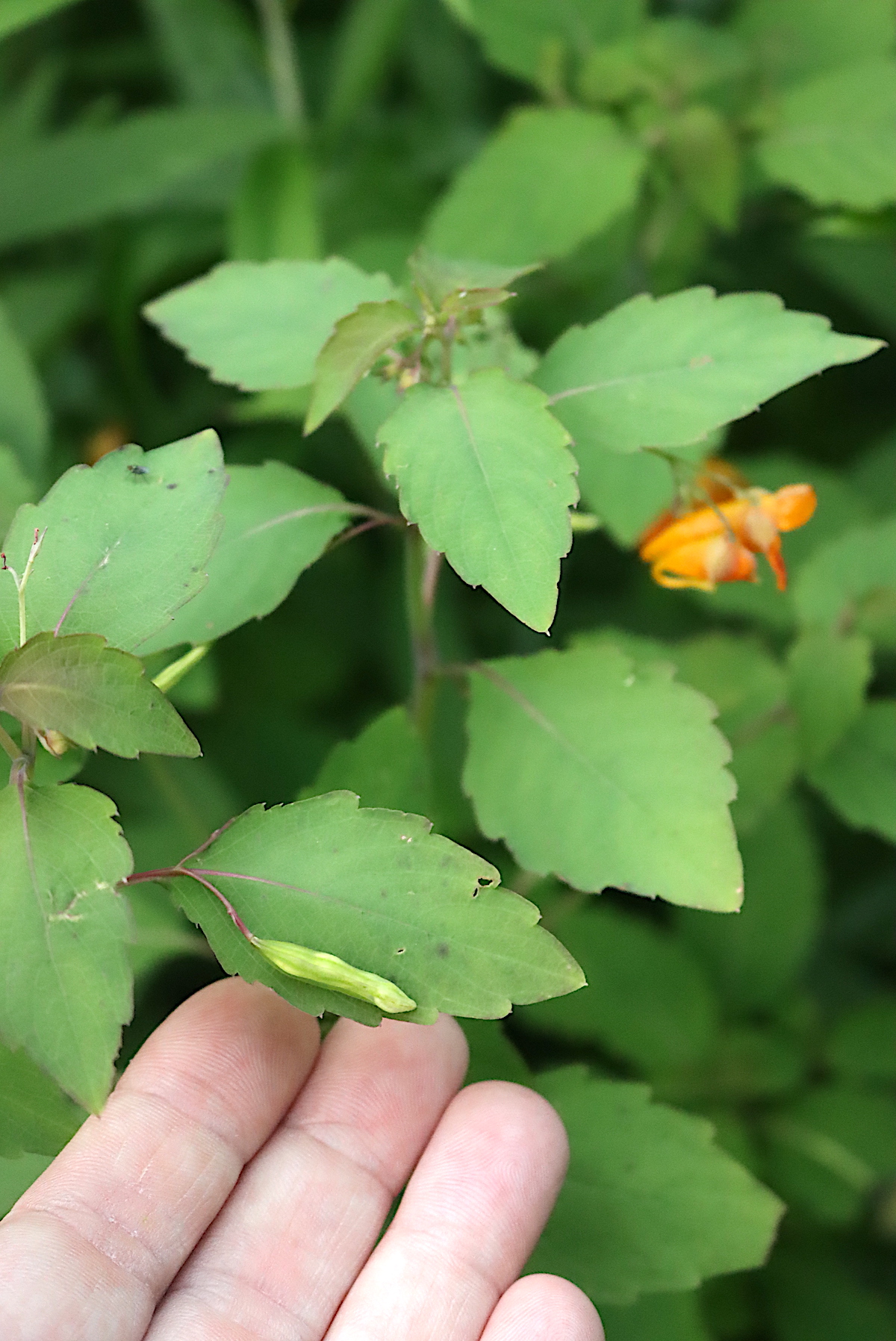
Jewelweed Medicinal Benefits
Historically, Jewelweed many Native American groups employed Jewelweed as a medicinal herb, and it is still popular today. It’s most frequently used externally to treat itching and skin irritations. Jewelweed is believed to have anti-inflammatory, anti-histamine, and anti-fungal properties, which are helpful in soothing poison ivy, nettle stings, bug bites, eczema, and other skin issues.
Herbalists often crush or chew Jewelweed into a quick poultice in the field. It’s a perfect solution after walking through a patch of nettles. However, herbalists also gather Jewelweed and process it into soaps, lotions, and salves to keep on hand for treating poison ivy rashes and other irritations as they occur.
One modern study, supported the use of Jewelweed for poison ivy. Researchers found that applying a Jewelweed mash after contact with poison ivy effectively reduced poison ivy dermatitis or rash. However, this study also indicated that Jewelweed soaps and extracts were less effective than the fresh plant.
Another study from 2001 explored the medicinal compounds found in Jewelweed. Researchers found that the plant contained compounds known to have anti-fungal, anti-itching, anti-mutagen, sedative, and anti-bacterial properties.
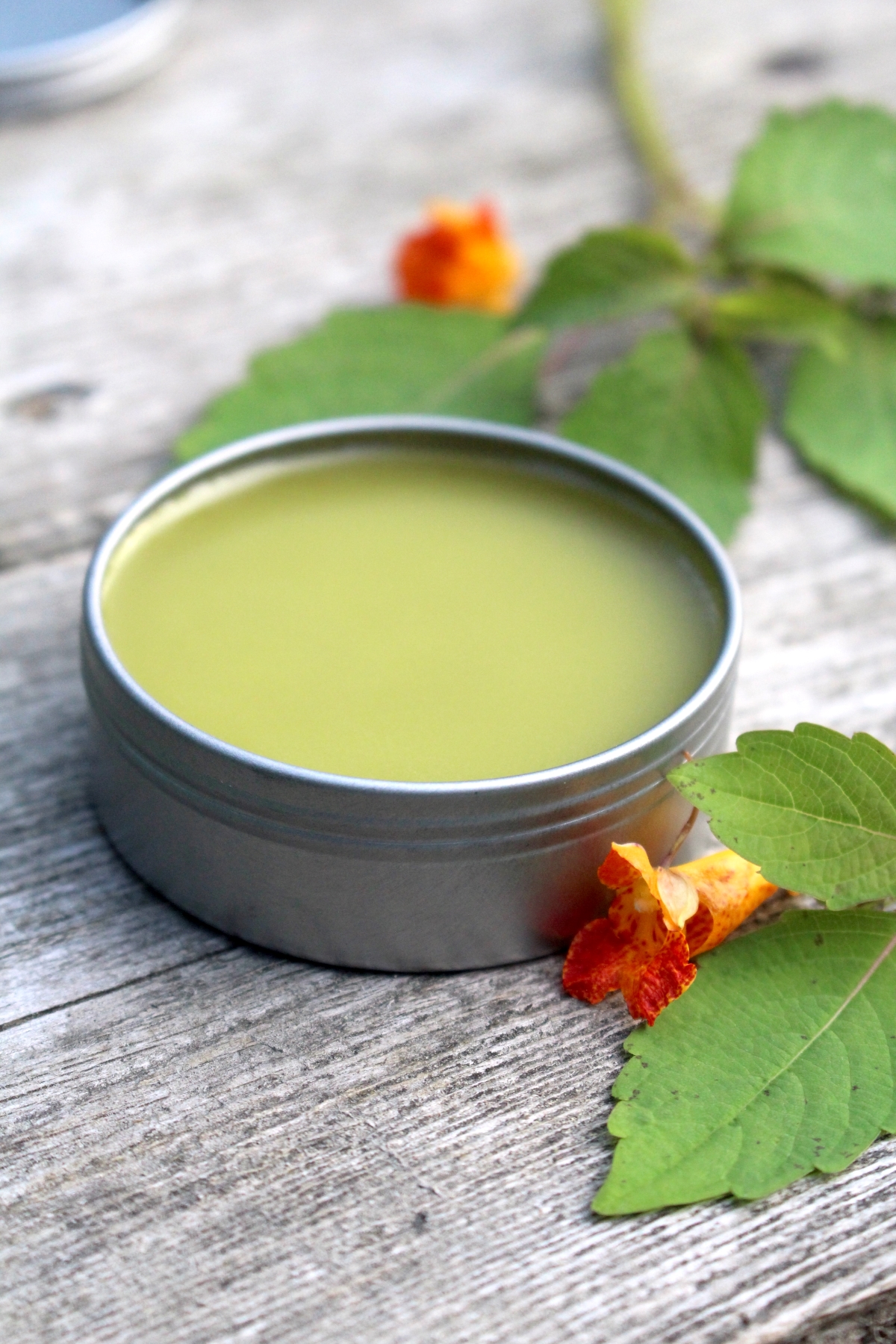
Where to Find Jewelweed
You can find Jewelweed in the eastern, northern, and northwestern United States as well as in eastern and western Canada.
Jewelweed thrives in damp, shaded areas. It’s commonly found in wooded lowlands, in disturbed areas like roadcuts and ditches, and along the margins of lakes, streams, bogs, and wetlands. It grows best in moist, humusy soil with an acidic or neutral pH.
When to Find Jewelweed
Jewelweed germinates in early spring, and you may spot small plants shortly after your area’s last frost date. In warm regions like the southeastern United States, Jewelweed may be spotted as early as March but will not germinate until much later in northern areas.
Jewelweed begins to flower by midsummer and will continue until fall frosts kill the plant.
Identifying Jewelweed
Jewelweed is often seen growing in large, dense patches that can be spotted from a distance. In optimum conditions, it will easily outcompete other plants, including invasives.
It’s a succulent, leafy plant that may grow 2 to 5 feet tall and has translucent stems and small nodding orange flowers.
The bluish-green leaves often have sparkling beads of dew or rain collected on them, giving the plant its name. If submerged in water, the leaves and stems appear silvery.

Jewelweed Flowers
Jewelweed has nodding, 1-inch flowers hanging from a slender stalk, which grows from the notch between an upper branch and the stem. The flowers typically grow in widely spread clusters of 1 to 3.
Jewelweed flowers are golden-orange splotched with brown or darker red-orange. Occasionally flowers may be pale yellow to almost white and can be unspotted.
The flowers feature bilateral symmetry and have five petals that often appear like just three at first inspection. The upper lip is formed from one petal, there are two lateral petals, and the other two are fused to form the lower lip, which functions as a landing pad for insects.
They have three sepals, one the same color as the petals and forming a sharply spurred sac that curves under the rest of the flower. The flowers attract hummingbirds, butterflies, and long-tongued bees like bumblebees.
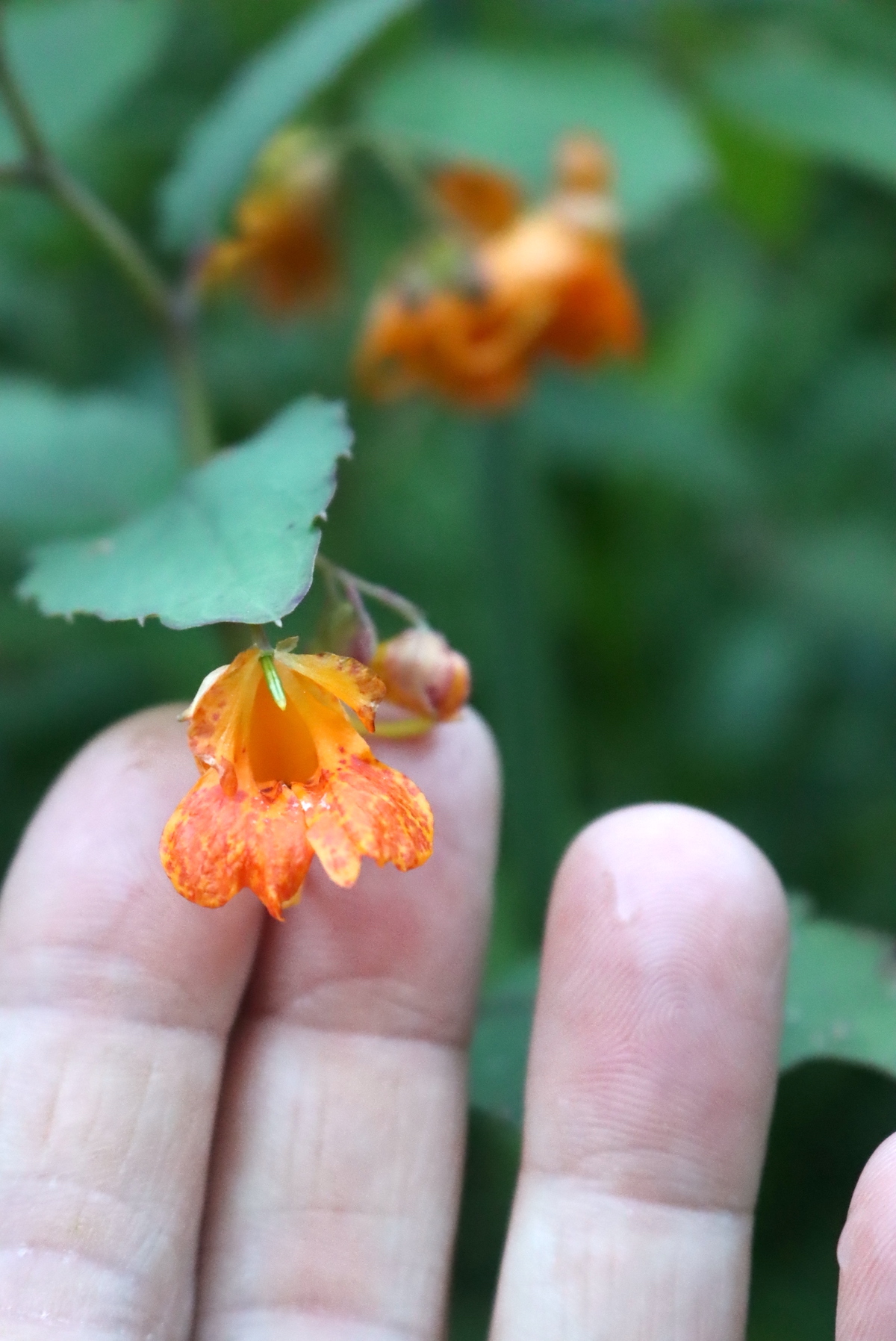
Jewelweed Leaves
Jewelweed leaves are alternately arranged, ovate-shaped, and usually grow 1½ to 3½ inches long. They are thin, somewhat succulent, bluish-green above and pale below.
Jewelweed leaves have coarsely toothed margins giving them a scalloped appearance.
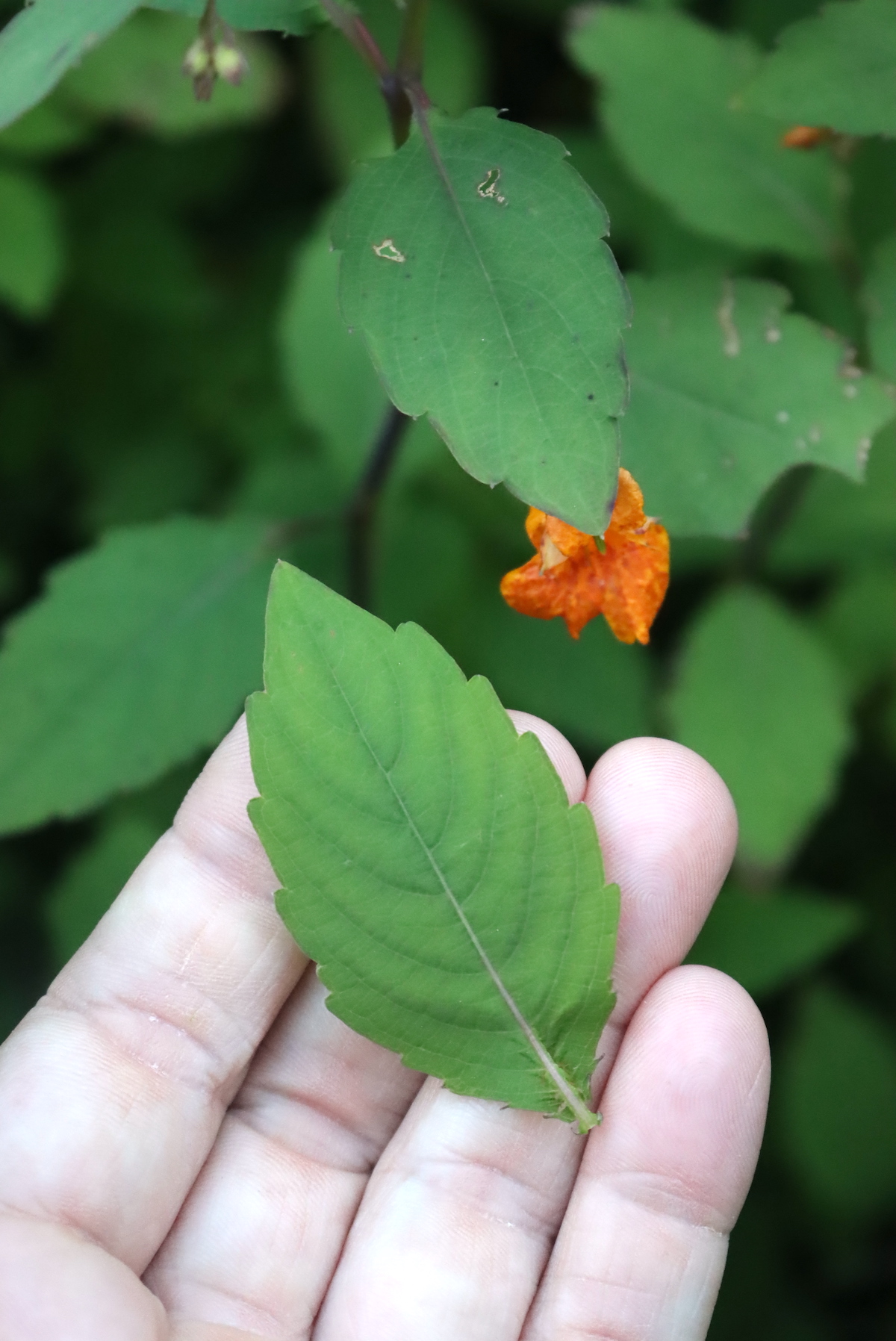
Jewelweed Stems
Jewelweed stems may grow from 2 to 5 feet tall and have a somewhat translucent, succulent appearance. They’re typically pale green to reddish green in color and may have swollen or darkened nodes.
The stems are somewhat weak and brittle, and you can destroy an entire stand of jewelweed just by walking through it. Watch out for that, as the plants are quite fragile.
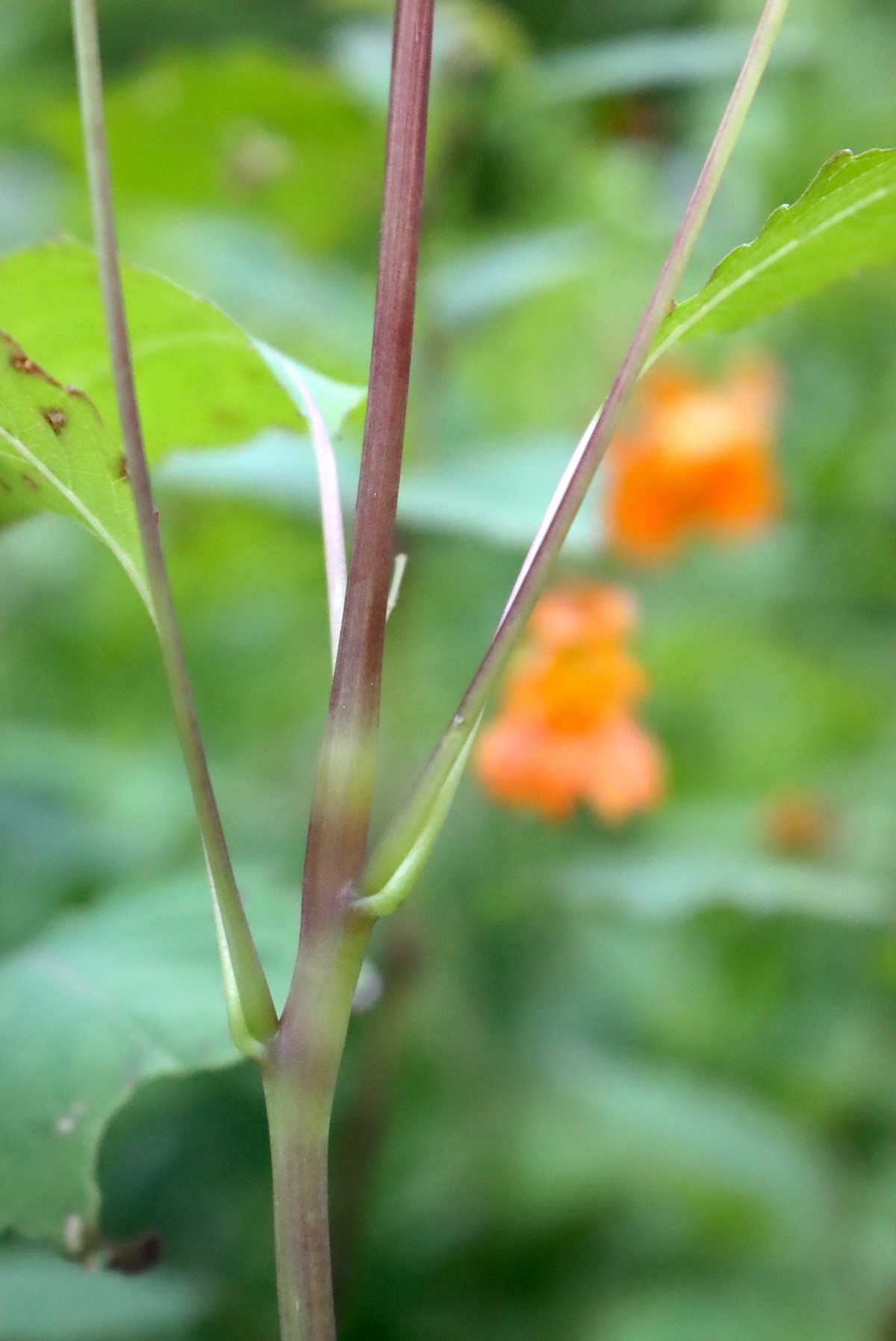
One reason that the plants are so fragile is the fact that the stems are hollow.
If you break a jewelweed stem in half, you should be able to look down it like a straw.
My kids, in fact, have used them as straws occasionally in the summertime for fun.
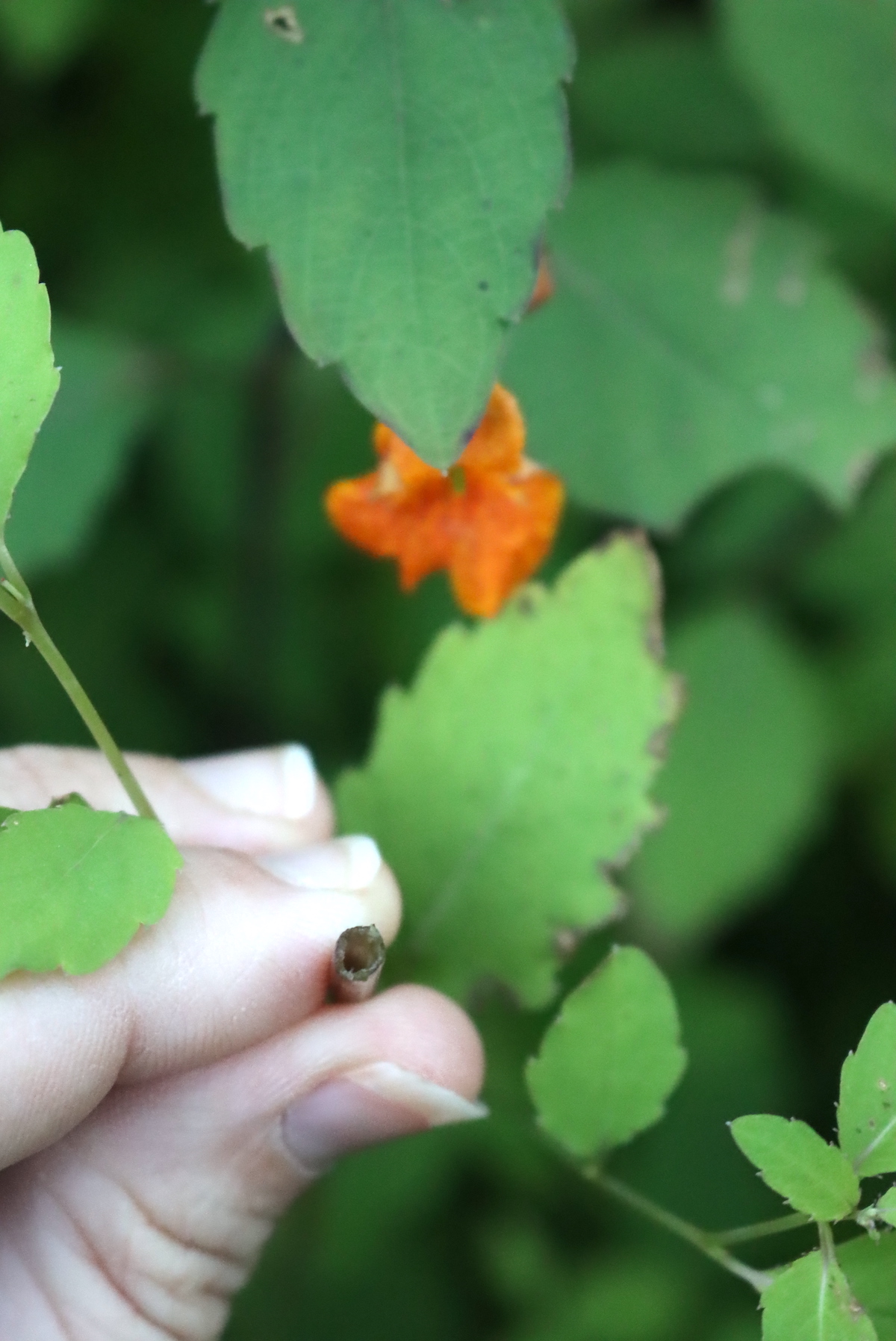
Jewelweed Seeds
Swollen, elongated seed capsules follow the flowers. The capsules are typically pale green and hang from the delicate flower stems. When fully mature, they burst open and project four to five green seeds, giving the plant its other common name, Touch-Me-Not.
The seeds shoot quite a ways, which helps the plant dispurse.

If you’re careful, you can pick the seed pods by their stems without touching them. This keeps them intact so you can eat them.
Believe it or not, jewelweed seeds taste just like walnuts, and they’re incredibly delicious.
Be sure to close your mouth quick, the pods will pop right as they touch your tongue.
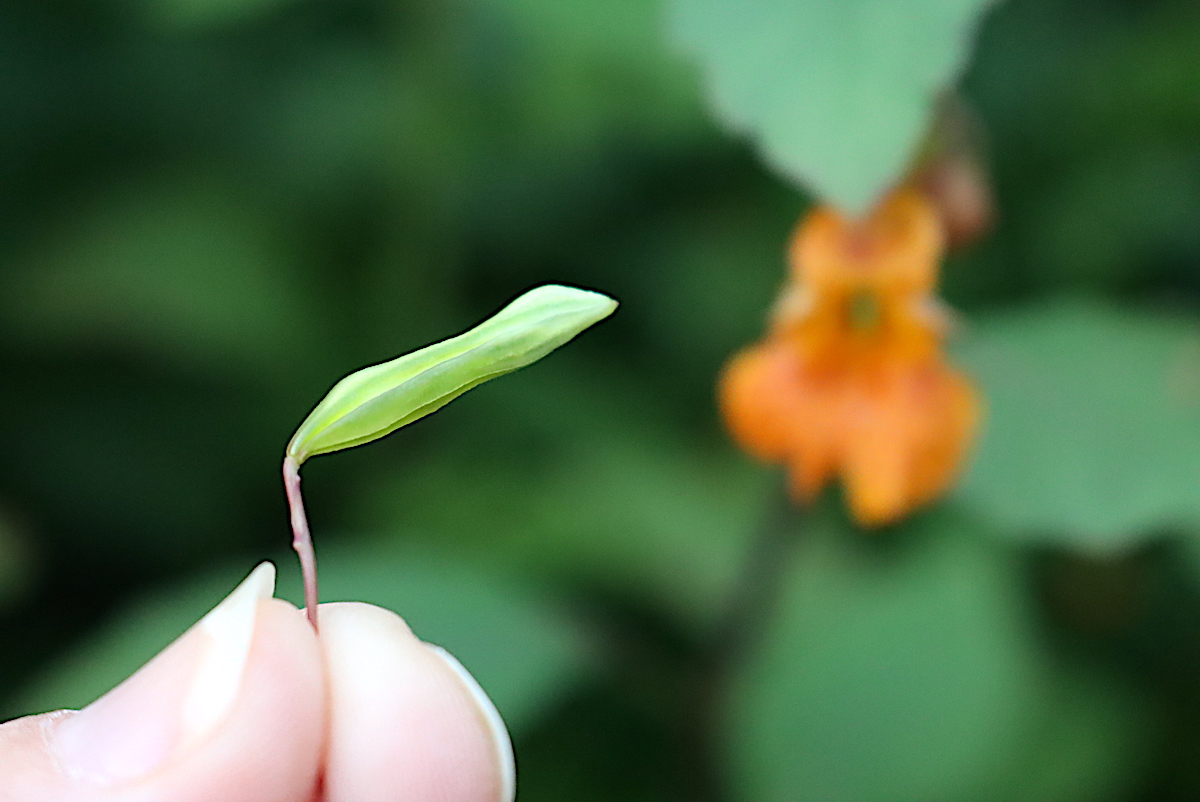
Once popped, the seed pod will curl up into a fleshy little morsel, and you can still eat that too.
The jewelweed seeds themselves are oblong and green, and some people think they look like jewels. Personally, I don’t really see the resemblance, but apparently that’s how they get their common name.
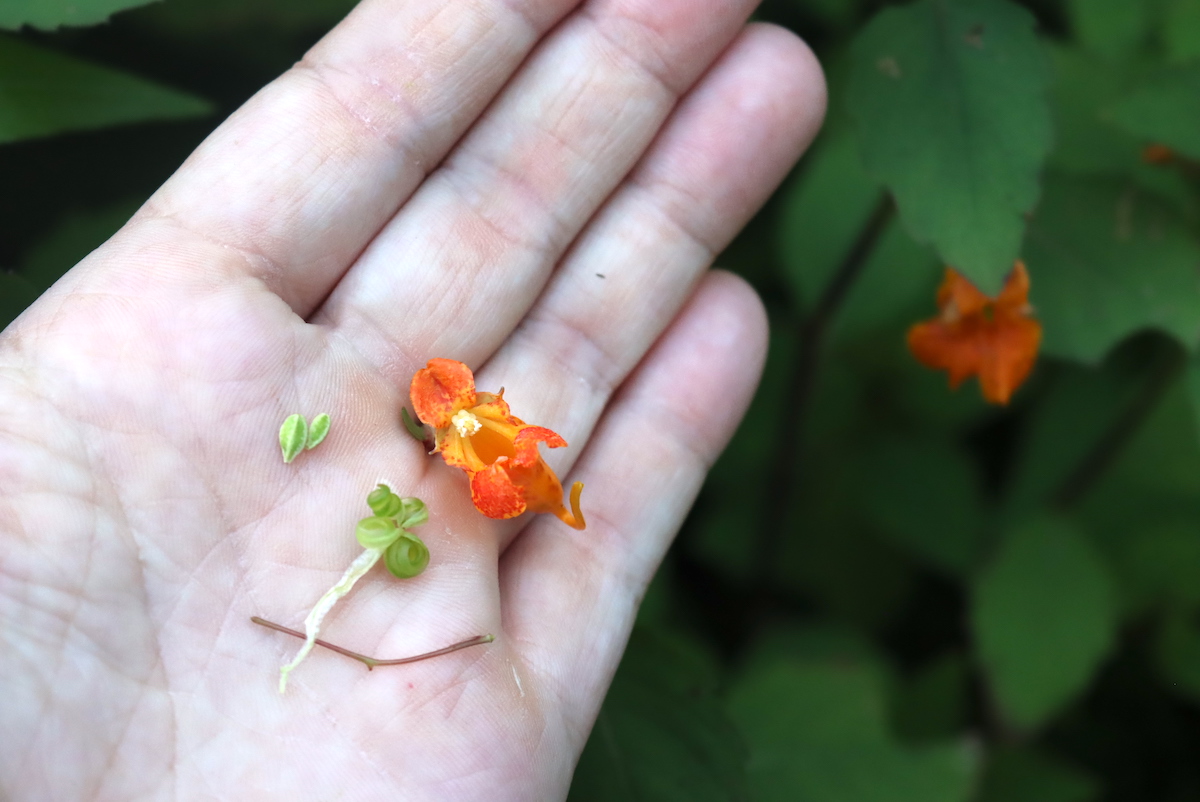
Jewelweed Look Alikes
Jewelweed is sometimes mistaken for other members of the Balsaminaceae family, like the invasive Himalayan Balsam (Impatiens glandulifera). However, Himalayan Balsam can be distinguished in a few ways:
- Himalayan Balsam leaves are oblong, sharply serrated, and have a red midrib.
- Himalayan Balsam leaves grow in pairs or whorled around the stem.
- Himalayan Balsam has pink or purple flowers.
Honestly, while the flowers have a similar shape, the plant doesn’t look all that similar…and the flowers are a pink/magenta rather than orange.
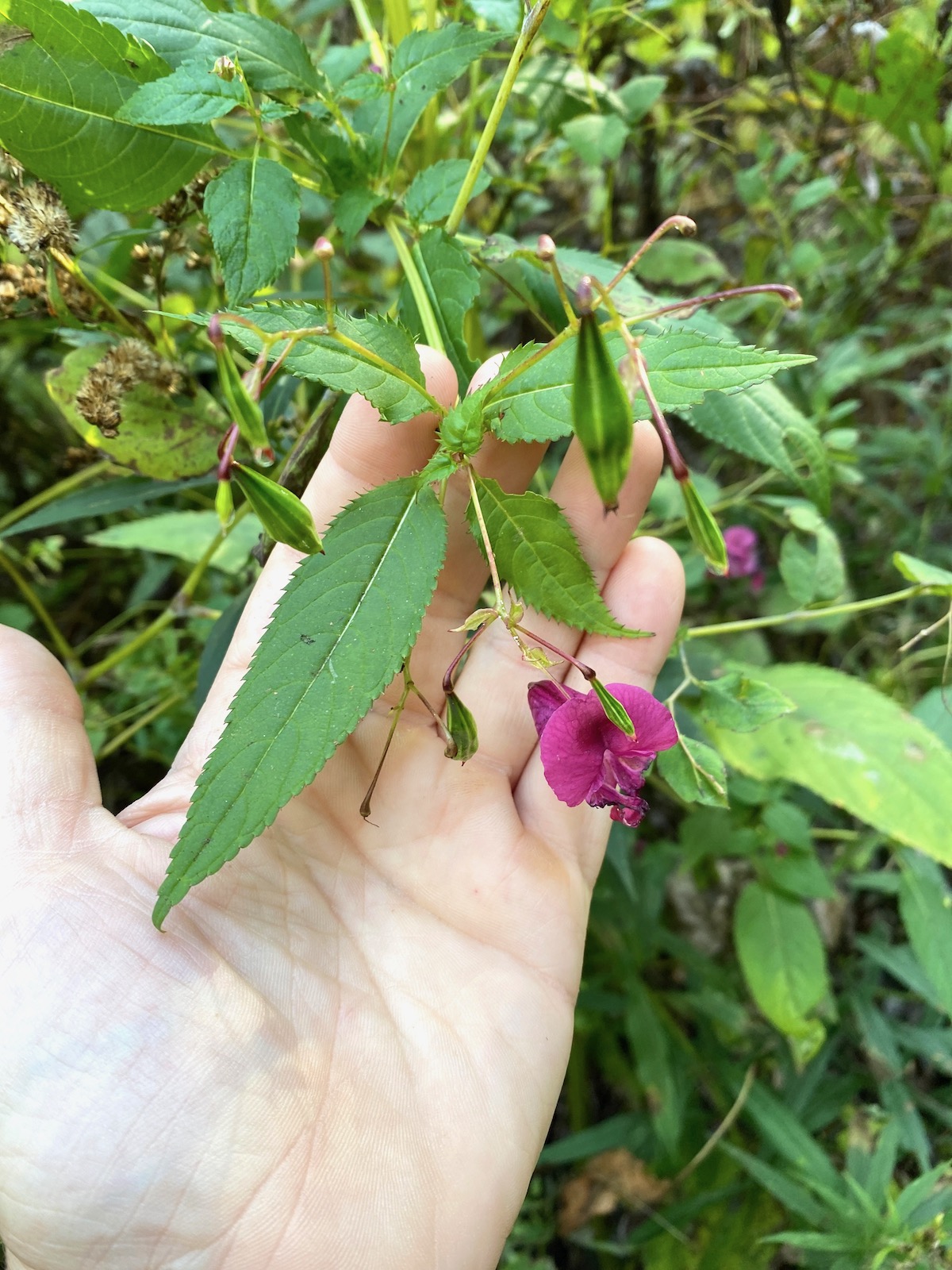
Jewelweed is also confused with the closely-related but less common Pale Jewelweed (Impatiens pallida). Jewelweed and Pale Jewelweed can often be found growing nearby.
- Pale Jewelweed is often taller, growing 3 to 6 feet in height.
- Pale Jewelweed has pale yellow flowers, which are occasionally splotched with reddish-brown.
Pale jewelweed is also edible, it just has a different color flower.
Ways to Use Jewelweed
You can eat fresh Jewelweed flowers, seed pods, and seeds. The seeds have a walnut-like flavor. The flowers are a great way to brighten up salads and baked goods.
Jewelweed’s young leaves and stems can be cooked and eaten like a pot herb. To cook Jewelweed, boil it for 10 to 12 minutes and change the water at least twice to remove some of the oxalic acid.
All parts of Jewelweed should be consumed in moderation, even when appropriately prepared.
One of the best ways to use Jewelweed is externally, as a medicinal herb. If you’re hiking through the woods and come into contact with nettles, poison ivy, or other irritating plants, look for a patch of Jewelweed. Mash or chew up Jewelweed leaves and stems and spread them on the areas of skin that came into contact with the plant.
You can also harvest some for later use. Place your fresh Jewelweed into a blender or food processor with some water. Blend, strain the plant material out, and then freeze the juice. This juice can be thawed or used frozen to help soothe skin irritations. Freezing the juice in ice cube trays is helpful if you want to use it frozen.
Alternatively, you can work Jewelweed into your own medicinal preparations. You can use Jewelweed in soap, lotion, and salves.
Jewelweed Recipes
If you’re looking for specific jewelweed recipes, I have a few to share:
- Learn to make your own cold process or melt and pour Jewelweed soap with the Nerdy Farm Wife.
- Try our Jewelweed Salve to help soothe itchy skin.
- Use Jewelweed seeds in salads like this Wild Salad recipe from The PBS Victory Garden.
Summer Foraging Guides
Jewelweed is at its best mid-summer, right at the peak of mosquito season. Around the same time, you can find literally hundreds of other wonderful edible and medicinal wild plants…
- Foraging Saskatoons
- Foraging Yarrow
- Foraging Plantain
- Foraging Pineappleweed (Wild Chamomile)
- Foraging Wild Gooseberries
Not sure what to look for? Check out my list of edible wild plants, edible wild berries and fruits, or edible garden weeds.
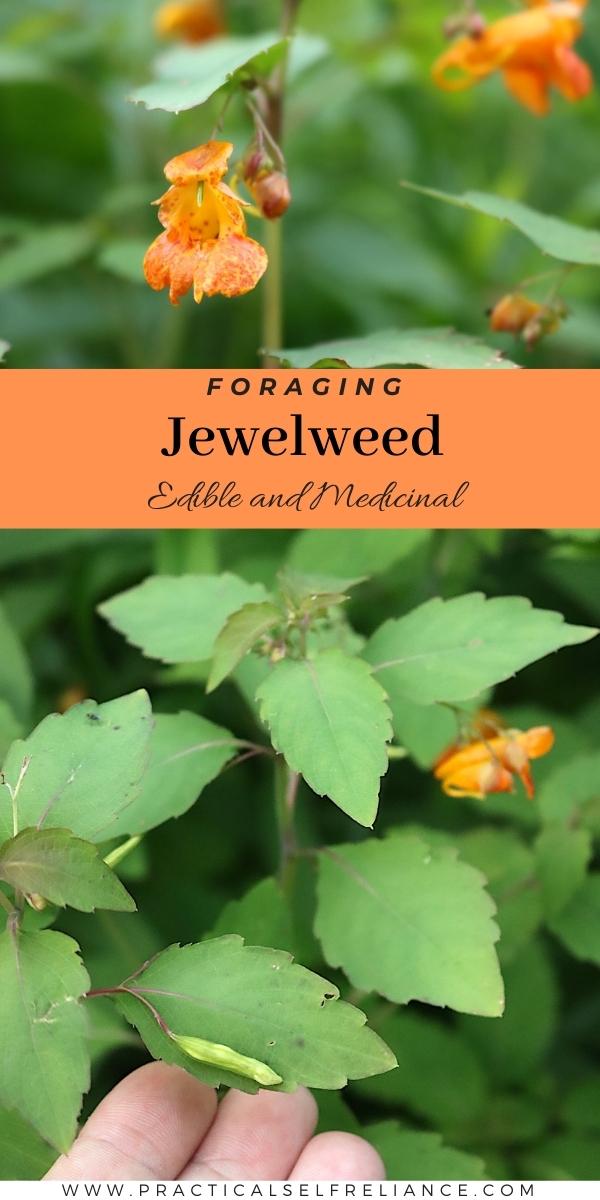

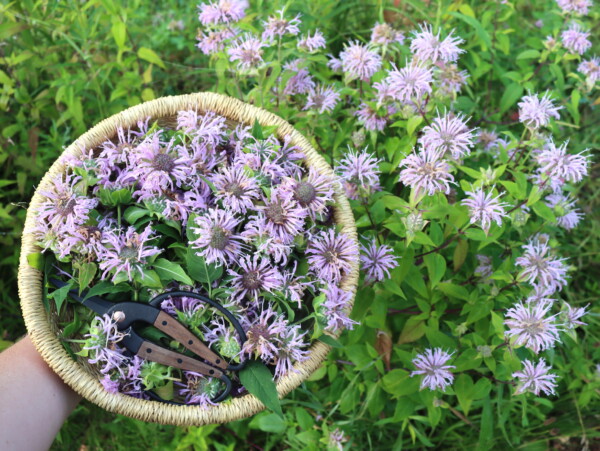
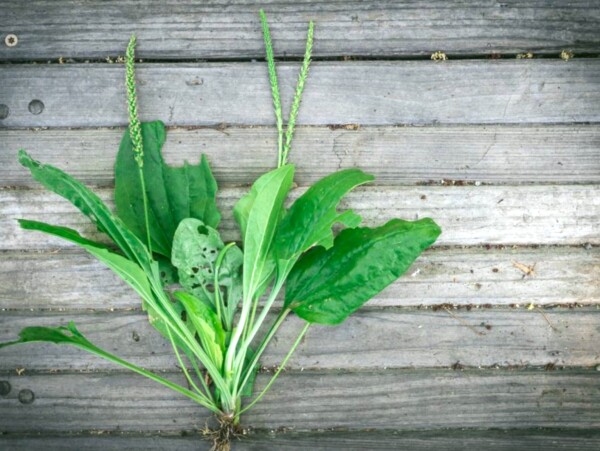
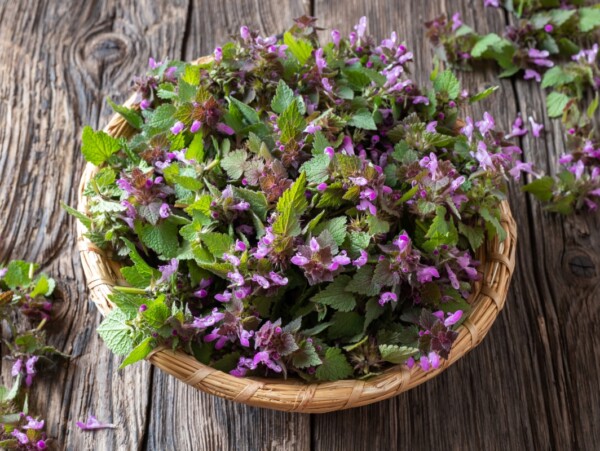










Thank you. I have learned many new things from this article. If you catch the mature dark seeds and carefully peel the green skin they are a beautiful jewel-like turquoise underneath. I always thought that was the origin of the name.
Thanks so much for all the great info! I just found some Jewelweed on our property yesterday and am going to make a salve.
Lovely!
Should the jewelweed be fresh or dried before processing?
You can use it fresh or dried but I prefer to use it fresh.
Hi, I loved your article. Just wanted to leave a comment about the origin of the name jewelweed.
While walking with a guide at our local arboretum we came across a patch of jewel weed. Water drops were captured on the leaves and were glistening brightly in the sunlight. The guide explained that jewelweed has microscopic hairs on the leaves that capture the water droplets which inturn glisten like jewels.
Thx again,
-Matt Mariano
Jewel Weed is also named because if you put a few drops of water on the leave they shine like diamond.
Good afternoon, Do you have any experience with how medicinal an oil infusion would be it the leaves and stem were dried/dehydrated before infusing?
In general it’s recommended to use fresh plant matter to get a stronger infusion but this sometimes depends on the plant. I don’t know if there are any studies out there to show this but it’s a common recommendation in the herbal world. I always try to use the fresh plant whenever possible.